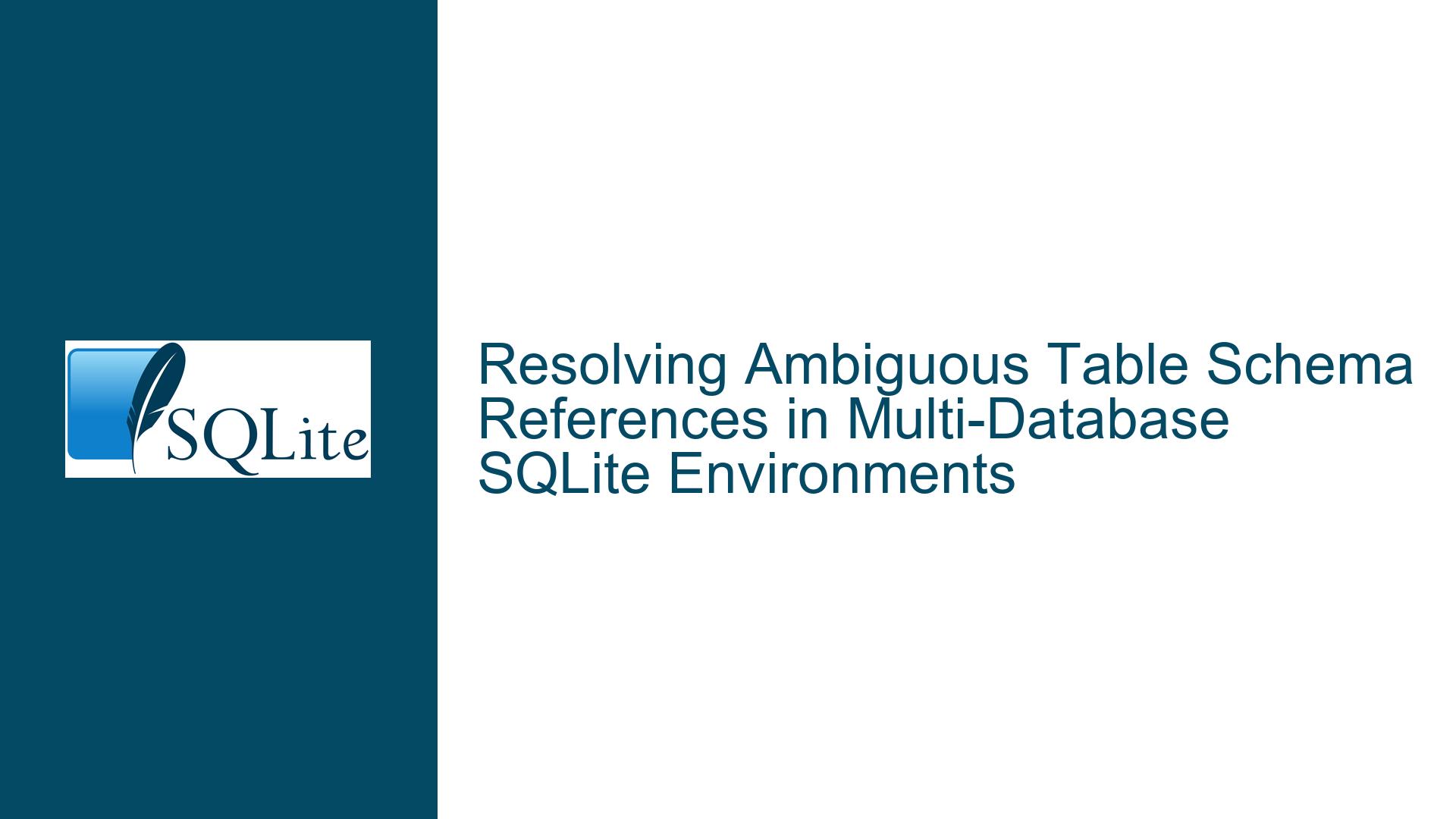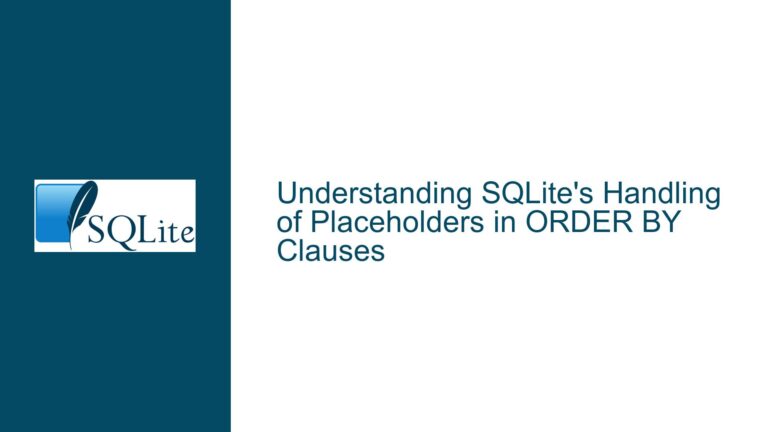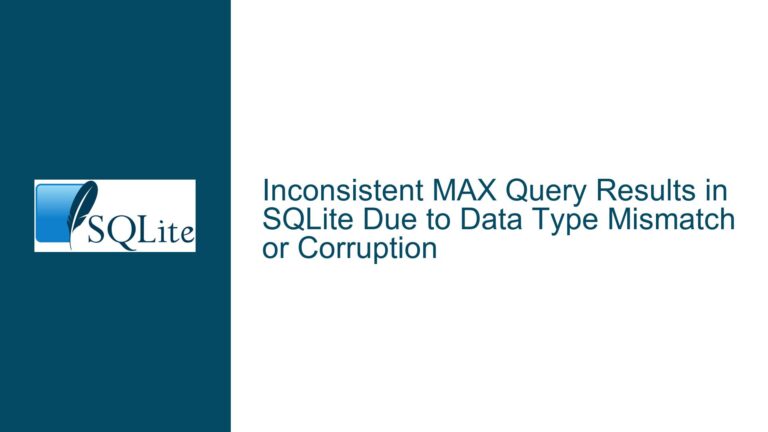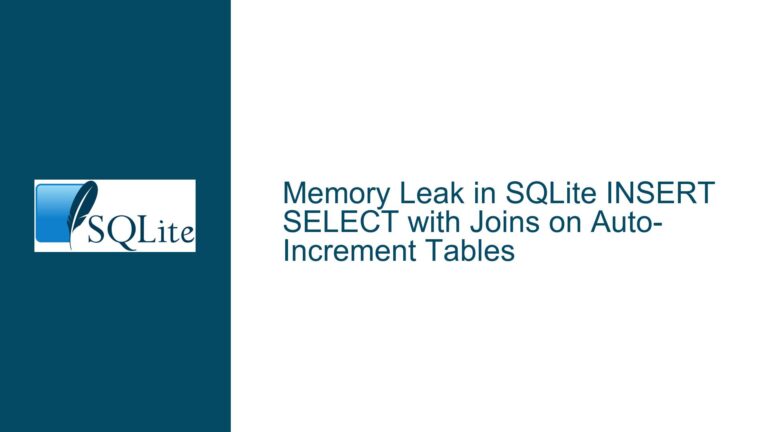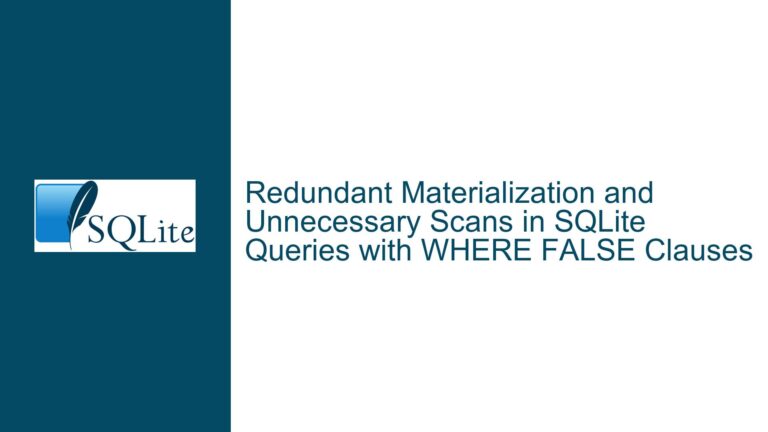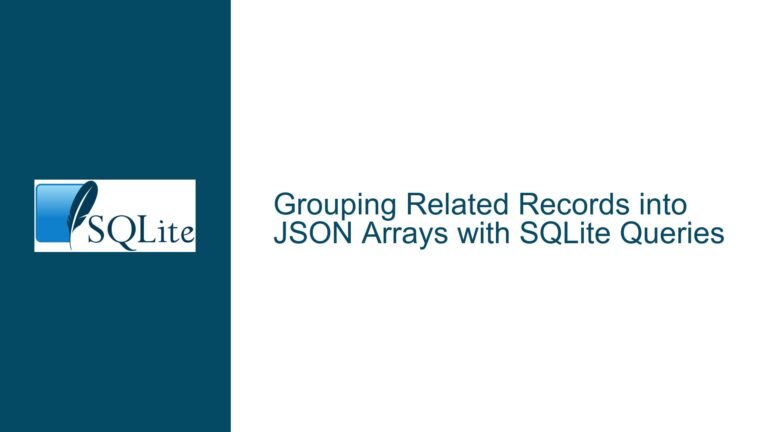Resolving Ambiguous Table Schema References in Multi-Database SQLite Environments
Understanding SQLite’s Schema Search Order for Table Resolution
Issue Overview
The core challenge revolves around determining which schema (database) SQLite will use when a table name appears in a query without explicit schema qualification (e.g., SELECT * FROM tblName instead of SELECT * FROM main.tblName). This becomes critical when multiple schemas are attached to a connection, especially if they contain tables with identical names. SQLite’s internal schema search order follows a specific hierarchy:
tempschema (in-memory temporary database).mainschema (primary database).- Attached schemas in the order they were attached (using
ATTACH DATABASE).
A table reference in a query will resolve to the first occurrence of the table name in this search order. The original discussion highlights attempts to replicate this resolution logic programmatically using SQL queries against metadata pragmas (pragma_table_list, pragma_database_list). However, initial implementations failed to account for the prioritization of the temp schema and the ordering of attached databases.
The problem extends further to determining the schema context for columns referenced in SQL statements (e.g., in WHERE clauses, ORDER BY). This introduces additional complexity because column resolution depends on the tables they originate from, which may themselves be ambiguously referenced.
Key complexities include:
- Schema Precedence Rules: The
tempschema is always searched first, even if other schemas were attached earlier. - Dynamic Attachment Order: Attached schemas are prioritized based on their attachment sequence, not alphabetically or by schema name.
- Metadata Pragmas: The
pragma_table_listandpragma_database_listpragmas provide raw metadata but do not inherently reflect SQLite’s internal search logic. - Edge Cases: Views, virtual tables, and temporary objects complicate resolution due to their transient nature or indirect references.
Root Causes of Incorrect Schema Resolution
1. Misuse of Metadata Pragmas Without Contextual Filtering
The pragma_table_list pragma returns all tables across all schemas, including system tables (e.g., sqlite_schema), views, and temporary tables. A naive query like:
SELECT schema FROM pragma_table_list WHERE name = 'tblName';
returns all schemas containing a table named tblName, without indicating which one SQLite would actually use in a query. This leads to incorrect assumptions if the first row in the result set does not align with SQLite’s search order.
2. Incorrect Join Logic Between Pragmas
The original query attempted to join pragma_table_list with pragma_database_list using schema = d.name, but this failed to account for the seq column in pragma_database_list, which defines the attachment order. The seq value for temp is always 1, while main has seq = 0. Attached schemas increment from seq = 2 onward. Without adjusting for this, sorting schemas by seq alone would prioritize main over temp, contradicting SQLite’s actual behavior.
3. Lack of Awareness of SQLite’s Internal Search Algorithm
SQLite resolves unqualified table names using a fixed sequence:
- Check
tempschema. - Check
mainschema. - Check attached schemas in the order of their
seqvalues (excludingtempandmain).
A query that does not replicate this order will fail to predict the correct schema. For example, sorting schemas by seq ascending would place main (seq=0) before temp (seq=1), which is incorrect.
4. Column Resolution Dependencies
Columns inherit their schema context from their parent tables. If a table’s schema is ambiguous, so are its columns. Parsing arbitrary SQL to resolve column schemas requires:
- Tokenizing the SQL to identify table aliases and explicit schema qualifiers.
- Mapping columns to their source tables, which may involve subqueries, joins, or CTEs.
- Handling edge cases like shadowed table names or columns with identical names across joined tables.
Comprehensive Solutions for Schema and Column Resolution
Step 1: Accurately Replicate SQLite’s Schema Search Order in Queries
To determine which schema SQLite will use for an unqualified table reference, construct a query that sorts schemas according to SQLite’s internal priority. Use the pragma_database_list.seq column to enforce the correct order:
SELECT
ptl.schema
FROM
pragma_table_list ptl
JOIN pragma_database_list pdl ON ptl.schema = pdl.name
WHERE
ptl.name = 'tblName'
ORDER BY
CASE
WHEN pdl.seq = 1 THEN -1 -- Prioritize 'temp' (seq=1)
ELSE pdl.seq
END
LIMIT 1;
Explanation:
- The
CASEstatement assigns-1to thetempschema (seq=1), forcing it to the top of the sorted list. - Other schemas are sorted by their
seqvalues:main(seq=0) comes next, followed by attached schemas (seq >= 2). LIMIT 1selects the first matching schema in this prioritized order.
Step 2: Handling Attached Schema Order Dynamically
When schemas are attached programmatically, their seq values increment starting from 2. To resolve conflicts between schemas attached in different sessions, store the attachment order in a application-managed registry or use a recursive CTE to dynamically assign priorities:
WITH db_priority (schema, priority) AS (
SELECT
name,
ROW_NUMBER() OVER (ORDER BY CASE WHEN name = 'temp' THEN 0 ELSE seq END)
FROM
pragma_database_list
)
SELECT
ptl.schema
FROM
pragma_table_list ptl
JOIN db_priority dp ON ptl.schema = dp.schema
WHERE
ptl.name = 'tblName'
ORDER BY
dp.priority
LIMIT 1;
Step 3: Resolving Column Schemas in Arbitrary SQL Statements
Determining the schema of a column mentioned in a SQL query requires parsing the query’s structure and context. This cannot be done reliably with static SQL queries alone. Instead:
Tokenize the SQL Statement:
- Identify table aliases and explicit schema qualifiers (e.g.,
main.tblName.col1). - Map columns to their source tables using the query’s
FROMandJOINclauses.
- Identify table aliases and explicit schema qualifiers (e.g.,
Leverage SQLite’s
sqlite3_stmtInterface:- Prepare the statement using
sqlite3_prepare_v3(). - Use
sqlite3_column_database_name()andsqlite3_column_table_name()to retrieve the schema and table for each column in the result set.
Example in C:
sqlite3_stmt *stmt; sqlite3_prepare_v3(db, "SELECT col1 FROM tblName", -1, 0, &stmt, NULL); const char *schema = sqlite3_column_database_name(stmt, 0); -- Returns 'main', 'temp', etc.- Prepare the statement using
Use the
sqlite_schemaTable with Caution:
Thesqlite_schematable (orsqlite_temp_schemafor temp objects) contains schema metadata, but querying it requires careful parsing of thesqlfield for table definitions.
Step 4: Addressing Edge Cases and Limitations
- Temporary Objects: Temporary tables (
temp.tblName) override same-named tables in other schemas. Always check for temporary objects first. - View Dependencies: Views may reference tables in other schemas. Use
PRAGMA view_info(viewName)to retrieve the underlying tables. - Shadowed Tables: If a table exists in both
tempandmain, thetempversion takes precedence. Ensure resolution logic accounts for this.
Step 5: Programmatic Workarounds for Complex Scenarios
When pure SQL is insufficient, use a hybrid approach:
- Extract Table Names from SQL: Use a parser or regex to identify all table references in the SQL string.
- Resolve Each Table’s Schema: Apply the schema resolution query (Step 1) to each table.
- Map Columns to Tables: For each column, determine its source table using the query’s structure, then inherit the table’s schema.
Example Workflow:
import sqlite3
import re
def resolve_schema(db_path, sql):
conn = sqlite3.connect(db_path)
tables = re.findall(r'\bFROM\s+(\w+)|JOIN\s+(\w+)', sql, re.IGNORECASE)
tables = [t[0] or t[1] for t in tables]
schemas = {}
for table in tables:
cursor = conn.execute(f"""
SELECT ptl.schema
FROM pragma_table_list ptl
JOIN pragma_database_list pdl ON ptl.schema = pdl.name
WHERE ptl.name = ?
ORDER BY CASE WHEN pdl.seq = 1 THEN -1 ELSE pdl.seq END
LIMIT 1;
""", (table,))
schemas[table] = cursor.fetchone()[0]
return schemas
Final Recommendations
- Explicit Schema Qualification: Always use
schema.tablesyntax in SQL statements to avoid ambiguity. - Avoid Shadowing: Do not create tables with the same name in multiple schemas unless absolutely necessary.
- Prefer Programmatic Resolution: Use SQLite’s C API or wrapper libraries (e.g., Python’s
sqlite3) to retrieve schema context at runtime.
This guide provides a rigorous methodology for resolving schema ambiguities in SQLite, combining metadata pragmas, query parsing, and programmatic techniques to address real-world complexities.
